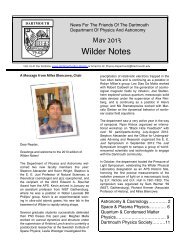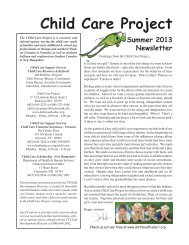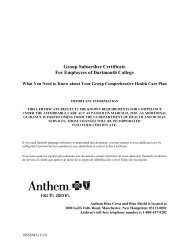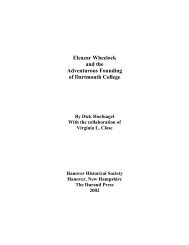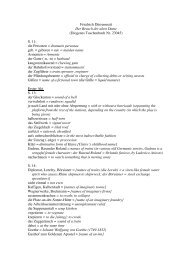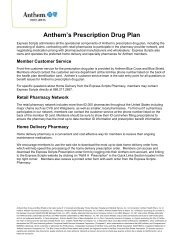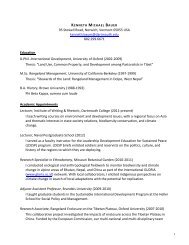Alcohol and cannabis use in schizophrenia: effects of clozapine vs ...
Alcohol and cannabis use in schizophrenia: effects of clozapine vs ...
Alcohol and cannabis use in schizophrenia: effects of clozapine vs ...
Create successful ePaper yourself
Turn your PDF publications into a flip-book with our unique Google optimized e-Paper software.
Abstract<br />
Schizophrenia Research 60 (2003) 81–85<br />
<strong>Alcohol</strong> <strong>and</strong> <strong>cannabis</strong> <strong>use</strong> <strong>in</strong> <strong>schizophrenia</strong>: <strong>effects</strong> <strong>of</strong><br />
clozap<strong>in</strong>e <strong>vs</strong>. risperidone<br />
Alan I. Green a,b,c, *, Ellen S. Burgess a,b,c , Ree Dawson a,d ,<br />
Suzannah V. Zimmet a,b,c , Rael D. Strous a,b,c<br />
a Commonwealth Research Center, Boston, MA, USA<br />
b Massach<strong>use</strong>tts Mental Health Center, Boston, MA, USA<br />
c Harvard Medical School, Department <strong>of</strong> Psychiatry, 74 Fenwood Road, Boston, MA 02115, USA<br />
d Frontier Science <strong>and</strong> Technology Research Foundation, Chestnut Hall, MA, USA<br />
Received 24 October 2001; received <strong>in</strong> revised form 9 February 2002; accepted 11 February 2002<br />
Background: <strong>Alcohol</strong> <strong>and</strong> <strong>cannabis</strong> <strong>use</strong> disorders worsen the course <strong>of</strong> <strong>schizophrenia</strong>. While the typical antipsychotics are <strong>of</strong><br />
limited value <strong>in</strong> controll<strong>in</strong>g substance <strong>use</strong> <strong>in</strong> schizophrenic patients, previous studies suggest that the novel antipsychotic<br />
clozap<strong>in</strong>e (CLOZ) may decrease their substance <strong>use</strong>. We describe a retrospective study <strong>of</strong> the <strong>effects</strong> <strong>of</strong> the novel antipsychotics<br />
risperidone (RISP) <strong>and</strong> clozap<strong>in</strong>e on alcohol <strong>and</strong> <strong>cannabis</strong> <strong>use</strong> <strong>in</strong> patients with <strong>schizophrenia</strong> or schizoaffective disorder <strong>and</strong><br />
comorbid alcohol <strong>and</strong>/or <strong>cannabis</strong> <strong>use</strong> disorder. Method: This study <strong>in</strong>volved retrospective assessment <strong>of</strong> abst<strong>in</strong>ence (cessation<br />
<strong>of</strong> alcohol <strong>and</strong> <strong>cannabis</strong> <strong>use</strong>) <strong>in</strong> 41 patients treated with either risperidone (n = 8) or clozap<strong>in</strong>e (n = 33) for at least 1 year. In 32 <strong>of</strong><br />
these 41 patients, <strong>in</strong>formation was available on whether abst<strong>in</strong>ence occurred dur<strong>in</strong>g the 1-year period. Results: Abst<strong>in</strong>ence rates<br />
were significantly higher <strong>in</strong> patients treated with clozap<strong>in</strong>e than <strong>in</strong> those treated with risperidone (54% <strong>vs</strong>. 13%, p = 0.05). The<br />
n<strong>in</strong>e patients treated for at least 1 year, but excluded from the analysis beca<strong>use</strong> time <strong>of</strong> cessation <strong>of</strong> <strong>use</strong> was not known, had all<br />
stopped alcohol/<strong>cannabis</strong> <strong>use</strong> dur<strong>in</strong>g clozap<strong>in</strong>e treatment. Discussion: While the limitations <strong>of</strong> this retrospective study must be<br />
recognized, the data suggest that comorbid patients treated with clozap<strong>in</strong>e are more likely to absta<strong>in</strong> from alcohol <strong>and</strong> <strong>cannabis</strong><br />
<strong>use</strong> than are those treated with risperidone. Further prospective studies will be required to confirm these <strong>in</strong>trigu<strong>in</strong>g results.<br />
D 2002 Elsevier Science B.V. All rights reserved.<br />
Keywords: Schizophrenia; Schizoaffective disorder; <strong>Alcohol</strong>; Cannabis; Clozap<strong>in</strong>e; Risperidone<br />
<strong>Alcohol</strong> <strong>use</strong> disorder, which is three times more<br />
common <strong>in</strong> patients with <strong>schizophrenia</strong> than <strong>in</strong> the<br />
general population, <strong>and</strong> <strong>cannabis</strong> <strong>use</strong> disorder, which<br />
is up to 10 times more common, both contribute to the<br />
* Correspond<strong>in</strong>g author. Harvard Medical School, Department<br />
<strong>of</strong> Psychiatry, 74 Fenwood Road, Boston, MA 02115, USA. Tel.:<br />
+1-617-232-5274; fax: +1-617-734-6206.<br />
E-mail address: alan_green@hms.harvard.edu (A.I. Green).<br />
0920-9964/02/$ - see front matter D 2002 Elsevier Science B.V. All rights reserved.<br />
PII: S0920-9964(02)00231-1<br />
www.elsevier.com/locate/schres<br />
morbidity <strong>of</strong> <strong>schizophrenia</strong>, through <strong>in</strong>creased relapse,<br />
noncompliance with treatment, more hospitalizations,<br />
<strong>and</strong> poorer overall function<strong>in</strong>g (Abram <strong>and</strong> Tepl<strong>in</strong>,<br />
1991; Bartels et al., 1991; Brady et al., 1990; DeQuardo<br />
et al., 1994; Drake <strong>and</strong> Mueser, 1996; Gupta et al.,<br />
1996; Knudsen <strong>and</strong> Vilmar, 1984; L<strong>in</strong>szen et al., 1994;<br />
Negrete et al., 1986; Owen et al., 1996; Peralta <strong>and</strong><br />
Cuesta, 1992; Regier et al., 1990; Richard et al., 1985;<br />
Smith et al., 1997; Swanson et al., 1990; Treffert,
82<br />
1978). Unfortunately, the typical antipsychotic agents,<br />
the ma<strong>in</strong>stay <strong>of</strong> treatment for <strong>schizophrenia</strong> for nearly<br />
50 years, are <strong>of</strong> limited value <strong>in</strong> controll<strong>in</strong>g alcohol or<br />
<strong>cannabis</strong> <strong>use</strong> <strong>in</strong> these ‘‘dual diagnosis’’ patients. However,<br />
case reports <strong>and</strong> prelim<strong>in</strong>ary data from our group<br />
<strong>and</strong> others suggest that the atypical antipsychotic drug<br />
clozap<strong>in</strong>e (CLOZ) may limit alcohol, <strong>cannabis</strong> <strong>and</strong><br />
other substance <strong>use</strong> <strong>in</strong> ‘‘dual diagnosis’’ patients with<br />
<strong>schizophrenia</strong> (Albanese et al., 1994; Buckley et al.,<br />
1999; Drake et al., 2000; Zimmet et al., 2000).<br />
The basis for the effect <strong>of</strong> CLOZ <strong>in</strong> patients<br />
comorbid for substance <strong>use</strong> disorder <strong>and</strong> <strong>schizophrenia</strong><br />
is not clear, but may relate to CLOZ’s effect on<br />
negative symptoms (Khantzian, 1997), its lack <strong>of</strong><br />
extrapyramidal system (EPS) <strong>effects</strong> (Siris, 1990), or<br />
its unique actions on the dopam<strong>in</strong>e-mediated mesocorticolimbic<br />
system (Green et al., 1999). Given this,<br />
we wondered whether the post-clozap<strong>in</strong>e novel antipsychotic<br />
risperidone (RISP), which has been reported<br />
to decrease negative symptoms <strong>and</strong> is associated with<br />
fewer EPS <strong>effects</strong> than typical antipsychotics (Marder<br />
<strong>and</strong> Meibach, 1994), would also share with CLOZ this<br />
beneficial effect on substance <strong>use</strong> <strong>in</strong> comorbid<br />
patients. Here, we report data from a retrospective<br />
study <strong>of</strong> alcohol <strong>and</strong>/or <strong>cannabis</strong> <strong>use</strong> <strong>in</strong> patients with<br />
<strong>schizophrenia</strong> or schizoaffective disorder treated with<br />
either RISP or CLOZ for a period <strong>of</strong> at least 1 year,<br />
<strong>and</strong> who had an active alcohol or <strong>cannabis</strong> <strong>use</strong><br />
disorder at the time <strong>of</strong> <strong>in</strong>itiation <strong>of</strong> treatment with<br />
the medication.<br />
1. Methods<br />
This retrospective study <strong>of</strong> alcohol <strong>and</strong> <strong>cannabis</strong><br />
<strong>use</strong> was conducted <strong>in</strong> patients treated with<strong>in</strong> the<br />
Massach<strong>use</strong>tts Mental Health Center (MMHC) outpatient<br />
department who were comorbid for alcohol<br />
<strong>and</strong>/or <strong>cannabis</strong> <strong>use</strong> disorder <strong>and</strong> <strong>schizophrenia</strong> or<br />
schizoaffective disorder. Patients were <strong>in</strong>cluded <strong>in</strong><br />
the study if: (1) they were currently be<strong>in</strong>g treated<br />
with or had previously been treated with risperidone<br />
(RISP) or clozap<strong>in</strong>e (CLOZ); (2) they had been<br />
treated with either medication for at least 1 year;<br />
<strong>and</strong> (3) they were known to have been us<strong>in</strong>g substances<br />
at the <strong>in</strong>itiation <strong>of</strong> treatment. The 1-year time<br />
frame was selected to ensure that patients would have<br />
a chance to demonstrate an effect <strong>of</strong> the treatment on<br />
A.I. Green et al. / Schizophrenia Research 60 (2003) 81–85<br />
alcohol or <strong>cannabis</strong> <strong>use</strong>. [Our previous studies suggest<br />
that 3 months is an adequate length <strong>of</strong> treatment for<br />
the effect <strong>of</strong> CLOZ <strong>in</strong> this population (Albanese et al.,<br />
1994; Zimmet et al., 2000; Drake et al., 2000), but the<br />
length <strong>of</strong> time for RISP is unknown.] Subjects for the<br />
study were identified through the outpatient department,<br />
via chart review <strong>and</strong> cl<strong>in</strong>ician <strong>in</strong>terview. The<br />
study was approved by the MMHC Human Studies<br />
Committee.<br />
Demographic <strong>and</strong> treatment <strong>in</strong>formation (gender,<br />
age, diagnosis, substances <strong>use</strong>d, current/previous dose<br />
<strong>of</strong> RISP or CLOZ, length <strong>of</strong> time treated with RISP or<br />
CLOZ) were obta<strong>in</strong>ed through chart reviews. In<br />
addition, cl<strong>in</strong>icians were asked: (1) to confirm that<br />
patients had been us<strong>in</strong>g alcohol <strong>and</strong>/or <strong>cannabis</strong> at the<br />
<strong>in</strong>itiation <strong>of</strong> RISP or CLOZ; (2) to rate any change <strong>in</strong><br />
alcohol/<strong>cannabis</strong> <strong>use</strong> achieved with RISP or CLOZ on<br />
a four-po<strong>in</strong>t scale (stopped <strong>use</strong>, decreased <strong>use</strong>, cont<strong>in</strong>ued<br />
at same level <strong>of</strong> <strong>use</strong>, <strong>in</strong>creased <strong>use</strong>); <strong>and</strong> (3) to<br />
rate, on a five-po<strong>in</strong>t scale, how soon after start<strong>in</strong>g<br />
RISP/CLOZ the change <strong>in</strong> alcohol/<strong>cannabis</strong> <strong>use</strong><br />
occurred (less than 1 month, 2–4 months, 5–11<br />
months, 1–2 years, greater than 2 years).<br />
For this study, we assessed the impact <strong>of</strong> treatment<br />
with either RISP or CLOZ on alcohol <strong>and</strong> <strong>cannabis</strong><br />
<strong>use</strong>. Our outcome measure was abst<strong>in</strong>ence, def<strong>in</strong>ed as<br />
cessation <strong>of</strong> all alcohol <strong>and</strong> <strong>cannabis</strong> <strong>use</strong>, noted by<br />
cl<strong>in</strong>icians to have started dur<strong>in</strong>g the first year <strong>of</strong><br />
treatment with RISP or CLOZ. (Abst<strong>in</strong>ence was<br />
chosen s<strong>in</strong>ce it is an important cl<strong>in</strong>ical outcome <strong>and</strong><br />
should have good reliability when assessed retrospectively,<br />
i.e., it is an all-or-noth<strong>in</strong>g phenomenon that<br />
would be likely to be noticed by the cl<strong>in</strong>ician. In this<br />
regard, Carey (1997) has reported that retrospective<br />
assessment <strong>of</strong> abst<strong>in</strong>ence from patient self-report has<br />
excellent validity <strong>in</strong> this population.) Patients treated<br />
with both RISP <strong>and</strong> CLOZ were excluded from<br />
analysis.<br />
Data analysis <strong>in</strong>cluded Chi-square analyses <strong>of</strong><br />
categorical data, us<strong>in</strong>g the Likelihood Ratio Test when<br />
there were more than 2 df <strong>and</strong> small cell sizes, <strong>and</strong> the<br />
t-test for <strong>in</strong>dependent samples for cont<strong>in</strong>uous data.<br />
2. Results<br />
With<strong>in</strong> the cl<strong>in</strong>ic, we identified 8 patients meet<strong>in</strong>g<br />
the <strong>in</strong>clusion criteria who had been treated with RISP,
Table 1<br />
Description <strong>of</strong> study subjects<br />
Variable Risperidone, n = 8 Clozap<strong>in</strong>e, n = 33 Test<br />
Gender Male, n = 5 (63%) Male, n = 26 (79%) x 2 (1) = 0.87<br />
Female, n = 3 (37%) Female, n = 7 (21%) p = 0.35<br />
Diagnosis Schizophrenia, n = 6 (75%) Schizophrenia, n = 24 (73%) x 2 (1) = 0.02<br />
Schizoaffective, n = 2 (25%) Schizoaffective, n = 9 (27%) p = 0.9<br />
Substance <strong>use</strong>d <strong>Alcohol</strong> only, n = 4 (50%) <strong>Alcohol</strong> only, n = 16 (49%) x 2 (2) = 0.68<br />
Cannabis only, n = 1 (13%) Cannabis only, n = 8 (24%) p = 0.71<br />
<strong>Alcohol</strong> + <strong>cannabis</strong>, n = 3 (37%) <strong>Alcohol</strong> + <strong>cannabis</strong>, n = 9 (27%)<br />
Number <strong>of</strong> substances <strong>use</strong>d One substance, n = 5 (63%) One substance, n = 24 (73%) x 2 (1) = 0.31<br />
Two substances, n = 3 (37%) Two substances, n = 9 (27%) p = 0.58<br />
Age Mean = 48.7 (SD = 16.4) Mean = 40.6 (SD = 7.7) T (7.8 a ) = 1.3<br />
p = 0.21<br />
Dose Mean = 3.9 (SD = 2.4) Mean = 439.6 (SD = 175.4) N/a<br />
Substance <strong>use</strong> outcome at 1 year Did not stop, n = 7 (87.5%) Did not stop, n = 11 (46%) x 2 (1) = 4.7<br />
Stopped, n = 1 (12.5%) Stopped, n = 13 (54%) p = 0.05<br />
a t-test for unequal variance.<br />
<strong>and</strong> 33 patients who had been treated with CLOZ.<br />
These two groups <strong>of</strong> patients are described <strong>in</strong> Table 1.<br />
Among the RISP-treated patients, 63% were male <strong>and</strong><br />
75% had <strong>schizophrenia</strong> (<strong>vs</strong>. schizoaffective disorder);<br />
among the CLOZ group, 79% were male <strong>and</strong> 73% had<br />
<strong>schizophrenia</strong>. The mean ages <strong>of</strong> the RISP <strong>and</strong> CLOZ<br />
groups were similar, 48.7 (SD = 16.4) <strong>and</strong> 40.6<br />
(SD = 7.7), respectively. In the RISP group, 50% <strong>of</strong><br />
the patients <strong>use</strong>d alcohol only, 13% <strong>use</strong>d <strong>cannabis</strong><br />
only, <strong>and</strong> 37% <strong>use</strong>d both alcohol <strong>and</strong> <strong>cannabis</strong>. Likewise,<br />
<strong>in</strong> the CLOZ group, 49% <strong>of</strong> the patients <strong>use</strong>d<br />
alcohol only, 24% <strong>use</strong>d <strong>cannabis</strong> only, <strong>and</strong> 27% <strong>use</strong>d<br />
both alcohol <strong>and</strong> <strong>cannabis</strong>. Patients <strong>in</strong> both groups<br />
were tak<strong>in</strong>g therapeutically appropriate doses <strong>of</strong> medication:<br />
for RISP, the mean daily dose = 3.9 mg,<br />
SD = 2.4; for CLOZ, it was 439.6 mg, SD = 175.4.<br />
In our exam<strong>in</strong>ation <strong>of</strong> the alcohol/<strong>cannabis</strong> <strong>use</strong><br />
outcome, we found that n<strong>in</strong>e CLOZ patients who<br />
had stopped alcohol/<strong>cannabis</strong> <strong>use</strong> were miss<strong>in</strong>g data<br />
on when the cessation occurred. Beca<strong>use</strong> we could not<br />
confirm that the cessation <strong>of</strong> alcohol <strong>and</strong>/or <strong>cannabis</strong><br />
<strong>use</strong> was <strong>in</strong>itiated with<strong>in</strong> the first year <strong>of</strong> treatment, we<br />
considered the substance <strong>use</strong> outcome as miss<strong>in</strong>g for<br />
these patients. We do not believe that exclud<strong>in</strong>g these<br />
patients biases the results as this <strong>in</strong>formation is most<br />
likely miss<strong>in</strong>g for reasons that are unrelated to the<br />
alcohol/<strong>cannabis</strong> <strong>use</strong> outcome (e.g., that the <strong>in</strong>formation<br />
was not written <strong>in</strong> the patient’s chart <strong>and</strong>/or that<br />
the cl<strong>in</strong>ician did not know or could not remember the<br />
time <strong>of</strong> cessation <strong>of</strong> <strong>use</strong>). Of the 24 CLOZ-treated<br />
patients with known ‘‘stop time’’ data, 13 stopped<br />
A.I. Green et al. / Schizophrenia Research 60 (2003) 81–85 83<br />
alcohol/<strong>cannabis</strong> <strong>use</strong> dur<strong>in</strong>g this period; <strong>of</strong> the 8<br />
RISP-treated patients, only 1 stopped alcohol/<strong>cannabis</strong><br />
<strong>use</strong> dur<strong>in</strong>g this period (54% <strong>vs</strong>. 12.5%, p = 0.05).<br />
In our survey <strong>of</strong> patients treated with RISP or<br />
CLOZ for at least 1 year, we noted that there were<br />
15 other patients <strong>in</strong> the cl<strong>in</strong>ic (12 treated with RISP<br />
<strong>and</strong> 3 treated with CLOZ) who met all the <strong>in</strong>clusion<br />
criteria for the study but who were excluded from the<br />
sample beca<strong>use</strong> they had been treated with RISP or<br />
CLOZ for less than one full year. These 15 patients did<br />
not differ from the 41 study patients on characteristics<br />
listed <strong>in</strong> Table 1, except for ages <strong>of</strong> 35.0 (SD = 10.9)<br />
<strong>vs</strong>. 42.2 years (SD = 10.2; t(54) = 2.0, p = 0.05), for the<br />
excluded <strong>and</strong> study patients, respectively. Ten <strong>of</strong> the<br />
RISP-treated patients <strong>and</strong> two <strong>of</strong> the CLOZ-treated<br />
patients had discont<strong>in</strong>ued medication treatment prior<br />
to 1 year; the other three patients were still tak<strong>in</strong>g their<br />
medication at the time <strong>of</strong> the survey.<br />
3. Discussion<br />
This retrospective study suggests that treatment<br />
with CLOZ is more likely to be associated with a<br />
cessation <strong>of</strong> alcohol <strong>and</strong>/or <strong>cannabis</strong> <strong>use</strong> than is treatment<br />
with RISP. Moreover, s<strong>in</strong>ce the n<strong>in</strong>e study<br />
patients not <strong>in</strong>cluded <strong>in</strong> the analysis due to lack <strong>of</strong><br />
documentation about when the cessation occurred all<br />
stopped alcohol/<strong>cannabis</strong> <strong>use</strong> while on CLOZ treatment,<br />
our results, while significant, are probably<br />
conservative.
84<br />
We were struck by the number <strong>of</strong> RISP-treated<br />
patients who discont<strong>in</strong>ued medication treatment prior<br />
to the 1-year mark, as compared to the CLOZ-treated<br />
patients. Further studies will be required to determ<strong>in</strong>e<br />
the reason for the high drop-out rate <strong>in</strong> the RISP group<br />
prior to 1 year <strong>of</strong> treatment. One possibility is that<br />
comorbid patients tend to have a poor cl<strong>in</strong>ical<br />
response to RISP with a cont<strong>in</strong>ued <strong>use</strong> <strong>of</strong> alcohol<br />
<strong>and</strong>/or <strong>cannabis</strong>.<br />
The basis for the lack <strong>of</strong> beneficial effect <strong>of</strong> RISP<br />
on comorbid alcohol or <strong>cannabis</strong> <strong>use</strong>, especially <strong>in</strong> the<br />
face <strong>of</strong> the apparent beneficial effect <strong>of</strong> CLOZ, is not<br />
clear. Both CLOZ <strong>and</strong> RISP are effective antipsychotic<br />
drugs, with good pr<strong>of</strong>iles for extrapyramidal<br />
system <strong>effects</strong> (compared to typical agents), <strong>and</strong> both<br />
drugs have been reported to decrease negative symptoms<br />
<strong>in</strong> patients (Krystal et al., 1999; Marder <strong>and</strong><br />
Meibach, 1994). The ‘‘self-medication’’ theories <strong>of</strong><br />
substance <strong>use</strong> <strong>in</strong> patients with <strong>schizophrenia</strong> (i.e., that<br />
substance <strong>use</strong> decreases negative symptoms or EPS<br />
<strong>effects</strong> from typical agents; Khantzian, 1985, 1997;<br />
Siris, 1990) would predict that CLOZ <strong>and</strong> RISP might<br />
both be effective agents <strong>in</strong> this population. The fact<br />
that only CLOZ appears likely to limit alcohol/<strong>cannabis</strong><br />
<strong>use</strong> suggests that the basis <strong>of</strong> this effect <strong>of</strong><br />
CLOZ may not relate to its <strong>effects</strong> on negative<br />
symptoms or its lack <strong>of</strong> EPS potential. We have<br />
suggested elsewhere (Green et al., 1999) that clozap<strong>in</strong>e’s<br />
effect on limit<strong>in</strong>g substance <strong>use</strong> <strong>in</strong> patients with<br />
<strong>schizophrenia</strong> may relate to its ability to ameliorate<br />
reward system defects <strong>in</strong> the dopam<strong>in</strong>e-mediated<br />
mesocorticolimbic circuits <strong>in</strong> these patients.<br />
We expect that our data should be generalizable to<br />
other cl<strong>in</strong>ic samples <strong>of</strong> chronic patients. This is beca<strong>use</strong><br />
we surveyed all the subjects <strong>in</strong> the cl<strong>in</strong>ic who met our<br />
diagnostic <strong>and</strong> treatment criteria, whether or not they<br />
were us<strong>in</strong>g substances at the time <strong>of</strong> <strong>in</strong>itiation <strong>of</strong> treatment<br />
with the study drugs <strong>and</strong> whether or not they had<br />
been treated for the full year period. Those comorbid<br />
patients not <strong>in</strong>cluded <strong>in</strong> this survey were be<strong>in</strong>g treated<br />
with antipsychotics other than those studied here or<br />
with multiple antipsychotics at the same time.<br />
The limitations <strong>of</strong> this retrospective study must be<br />
recognized. First, the sample sizes are modest. Second,<br />
despite the lack <strong>of</strong> demographic differences <strong>in</strong><br />
the patients treated with CLOZ compared to those<br />
treated with RISP, the groups may differ on the reason<br />
for medication choice (i.e., patients treated with<br />
A.I. Green et al. / Schizophrenia Research 60 (2003) 81–85<br />
CLOZ were treatment refractory or <strong>in</strong>tolerant <strong>and</strong><br />
the RISP patients were not). However, s<strong>in</strong>ce all<br />
patients were <strong>of</strong>fered the same substance ab<strong>use</strong> services,<br />
there should be no particular bias regard<strong>in</strong>g the<br />
alcohol/<strong>cannabis</strong> <strong>use</strong> outcome. Third, the greater frequency<br />
<strong>of</strong> cl<strong>in</strong>ic visits for the CLOZ patients (weekly<br />
visits for white blood counts) compared to those<br />
treated with RISP could itself have contributed to<br />
<strong>in</strong>creased abst<strong>in</strong>ence. Fourth, lack <strong>of</strong> data on how long<br />
the abst<strong>in</strong>ence cont<strong>in</strong>ued may limit the strength <strong>of</strong> our<br />
conclusions. We do know, however, that patients<br />
stopped their substance <strong>use</strong> with<strong>in</strong> the first year <strong>of</strong><br />
treatment <strong>and</strong> appeared to cont<strong>in</strong>ue such abst<strong>in</strong>ence at<br />
least until the end <strong>of</strong> that year period.<br />
Prospective, double-bl<strong>in</strong>d studies, <strong>in</strong> which patients<br />
are r<strong>and</strong>omised to study treatment, will be<br />
required to confirm these retrospective data. Such<br />
studies are currently underway to further assess<br />
whether RISP or other novel antipsychotics share<br />
CLOZ’s apparent ability to limit substance <strong>use</strong> <strong>in</strong><br />
patients with <strong>schizophrenia</strong>.<br />
Acknowledgements<br />
Supported <strong>in</strong> part by grants from NIMH (MH<br />
49891, MH 52376), NIAAA (AA 11904), NIDA (DA<br />
13196), Novartis Pharmaceuticals, <strong>and</strong> by the Commonwealth<br />
Research Center.<br />
References<br />
Abram, K.M., Tepl<strong>in</strong>, L.A., 1991. Co-occurr<strong>in</strong>g disorder among<br />
mentally ill jail deta<strong>in</strong>ees: implications for public policy. Am.<br />
Psychol. 46, 1036–1045.<br />
Albanese, M.J., Khantzian, E.J., Murphy, S.I., Green, A.I., 1994.<br />
Decreased substance <strong>use</strong> <strong>in</strong> chronically psychotic patients treated<br />
with clozap<strong>in</strong>e. Am. J. Psychiatry 151, 780–781.<br />
Bartels, S.J., Drake, R.E., Wallach, M.A., Freeman, D.H., 1991.<br />
Characteristic hostility <strong>in</strong> schizophrenic outpatients. Schizophr.<br />
Bull. 17, 163–171.<br />
Brady, K., Anton, R., Ballenger, J.C., Lydiard, R.B., Ad<strong>in</strong><strong>of</strong>f, B.,<br />
Sal<strong>and</strong>er, J., 1990. Coca<strong>in</strong>e ab<strong>use</strong> among schizophrenic patients.<br />
Am. J. Psychiatry 147, 1164–1167.<br />
Buckley, P., McCarthy, M., Chapman, P., Richman, C., Yammamoto,<br />
B., 1999. Clozap<strong>in</strong>e treatment <strong>of</strong> comorbid substance ab<strong>use</strong><br />
<strong>in</strong> patients with <strong>schizophrenia</strong>. Schizophr. Res. 36, 272.<br />
Carey, K.B., 1997. Challenges <strong>in</strong> assess<strong>in</strong>g substance <strong>use</strong> patterns<br />
<strong>in</strong> persons with comorbid mental <strong>and</strong> addictive disorders. In:<br />
Onken, L., Bla<strong>in</strong>e, J.D., Genser, S., Horton, A.M. (Eds.), Treat-
ment <strong>of</strong> Drug-Dependent Individuals with Comorbid Mental<br />
Disorders. NIDA Research Monograph, vol. 172. Super<strong>in</strong>tendent<br />
<strong>of</strong> Documents, US Government Pr<strong>in</strong>t<strong>in</strong>g Office, Wash<strong>in</strong>gton,<br />
DC, pp. 16–32. NIH Pub. No. 97-4172.<br />
DeQuardo, J.R., Carpenter, C.F., T<strong>and</strong>on, R., 1994. Patterns <strong>of</strong> substance<br />
ab<strong>use</strong> <strong>in</strong> <strong>schizophrenia</strong>: nature <strong>and</strong> significance. J. Psychiatr.<br />
Res. 28, 267–275.<br />
Drake, R.E., Mueser, K.T., 1996. <strong>Alcohol</strong> <strong>use</strong> disorder <strong>and</strong> severe<br />
mental illness. <strong>Alcohol</strong> Health Res. World 20, 87–93.<br />
Drake, R.E., Xie, H., McHugo, G.I., Green, A.I., 2000. The <strong>effects</strong><br />
<strong>of</strong> clozap<strong>in</strong>e on alcohol <strong>and</strong> drug <strong>use</strong> disorder among schizophrenic<br />
patients. Schizophr. Bull. 26, 441–449.<br />
Green, A.I., Zimmet, S.V., Strous, R.D., Schildkraut, J.J., 1999.<br />
Clozap<strong>in</strong>e for comorbid substance <strong>use</strong> disorder <strong>and</strong> <strong>schizophrenia</strong>:<br />
do patients with <strong>schizophrenia</strong> have a reward-deficiency<br />
syndrome that can be ameliorated by clozap<strong>in</strong>e? Harv. Rev.<br />
Psychiatry 6, 287–296.<br />
Gupta, S., Hendricks, S., Kenkel, A.M., Bhatoa, S.C., Haffke, E.A.,<br />
1996. Relapse <strong>in</strong> <strong>schizophrenia</strong>: is there a relationship to substance<br />
ab<strong>use</strong>. Schizophr. Res. 20, 153–156.<br />
Khantzian, E.J., 1985. A self-medication hypothesis <strong>of</strong> addictive<br />
disorders: focus on hero<strong>in</strong> <strong>and</strong> coca<strong>in</strong>e dependence. Am. J. Psychiatry<br />
142, 1259–1264.<br />
Khantzian, E.J., 1997. The self-medication hypothesis <strong>of</strong> substance<br />
<strong>use</strong> disorder: a reconsideration <strong>and</strong> recent application. Harv.<br />
Rev. Psychiatry 4, 231–244.<br />
Knudsen, P., Vilmar, T., 1984. Cannabis <strong>and</strong> neuroleptic agents <strong>in</strong><br />
<strong>schizophrenia</strong>. Acta Psychiatr. Sc<strong>and</strong>. 69, 162–174.<br />
Krystal, J.H., D’Souza, D.C., Madonick, S., Petrakis, I.L., 1999.<br />
Toward a rational pharmacotherapy <strong>of</strong> comorbid substance<br />
ab<strong>use</strong> <strong>in</strong> <strong>schizophrenia</strong> patients. Schizophr. Res., s35–s49.<br />
L<strong>in</strong>szen, D.H., D<strong>in</strong>gemans, P.M., Lenior, M.E., 1994. Cannabis<br />
ab<strong>use</strong> <strong>and</strong> the course <strong>of</strong> recent-onset schizophrenic disorder.<br />
Arch. Gen. Psychiatry 51, 273–279.<br />
A.I. Green et al. / Schizophrenia Research 60 (2003) 81–85 85<br />
Marder, S.R., Meibach, R.C., 1994. Risperidone <strong>in</strong> the treatment <strong>of</strong><br />
<strong>schizophrenia</strong>. Am. J. Psychiatry 151, 825–835.<br />
Negrete, J.C., Knapp, W.P., Douglas, D.E., Smith, W.B., 1986.<br />
Cannabis affects the severity <strong>of</strong> schizophrenic symptoms: results<br />
<strong>of</strong> a cl<strong>in</strong>ical survey. Psychol. Med. 16, 515–520.<br />
Owen, R.R., Fischer, E.P., Booth, B.M., Cuffel, B.J., 1996. Medication<br />
noncompliance <strong>and</strong> substance ab<strong>use</strong> among patients with<br />
<strong>schizophrenia</strong>. Psychiatr. Serv. 47, 853–858.<br />
Peralta, V., Cuesta, M.J., 1992. Influence <strong>of</strong> <strong>cannabis</strong> ab<strong>use</strong> on<br />
schizophrenic psychopathology. Acta Psychiatr. Sc<strong>and</strong>. 85,<br />
127–130.<br />
Regier, D.A., Farmer, M.E., Rae, D.S., Locke, B.Z., Keith, S.J.,<br />
Judd, L.L., Goodw<strong>in</strong>, K.K., 1990. Comorbidity <strong>of</strong> mental disorders<br />
with alcohol <strong>and</strong> other drug ab<strong>use</strong>. J. Am. Med. Assoc.<br />
264, 2511 – 2518.<br />
Richard, M.L., Liscow, B.I., Perry, P.J., 1985. Recent psychostimulant<br />
<strong>use</strong> <strong>in</strong> hospitalized schizophrenics. J. Cl<strong>in</strong>. Psychol. 46,<br />
79–83.<br />
Siris, S.G., 1990. Pharmacological treatment <strong>of</strong> substance-abus<strong>in</strong>g<br />
<strong>schizophrenia</strong> patients. Schizophr. Bull. 16, 111 –122.<br />
Smith, C.M., Barzman, D., Pristach, C.A., 1997. Effect <strong>of</strong> patient<br />
<strong>and</strong> family <strong>in</strong>sight on compliance <strong>of</strong> schizophrenic patients. J.<br />
Cl<strong>in</strong>. Pharmacol. 37, 147–154.<br />
Swanson, J.W., Holzer, C.E., Ganju, V.K., Jono, R.T., 1990. Violence<br />
<strong>and</strong> psychiatric disorder <strong>in</strong> the community: evidence from<br />
the Epidemiological Catchment Area Survey. Hosp. Comm.<br />
Psychiatry 41, 761–770.<br />
Treffert, D.A., 1978. Marijuana <strong>use</strong> <strong>in</strong> <strong>schizophrenia</strong>: a clear hazard.<br />
Am. J. Psychiatry 135, 1213–1215.<br />
Zimmet, S.V., Strous, R.D., Burgess, E.S., Kohnstamm, S., Green,<br />
A.I., 2000. Effects <strong>of</strong> clozap<strong>in</strong>e on substance <strong>use</strong> <strong>in</strong> patients with<br />
<strong>schizophrenia</strong> <strong>and</strong> schizoaffective disorder: a retrospective survey.<br />
J. Cl<strong>in</strong>. Psychopharmacol. 20, 94–98.



